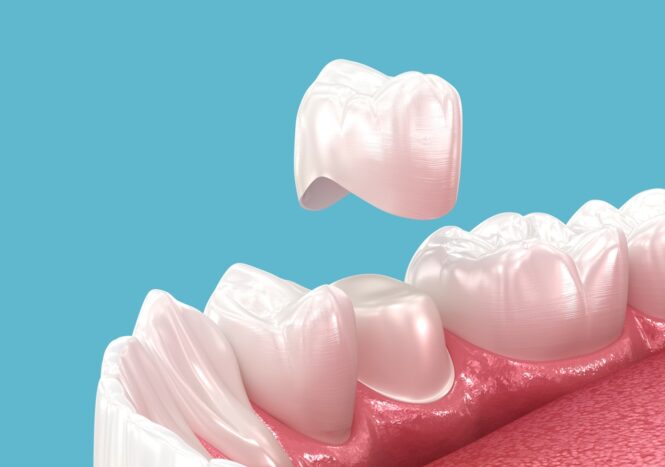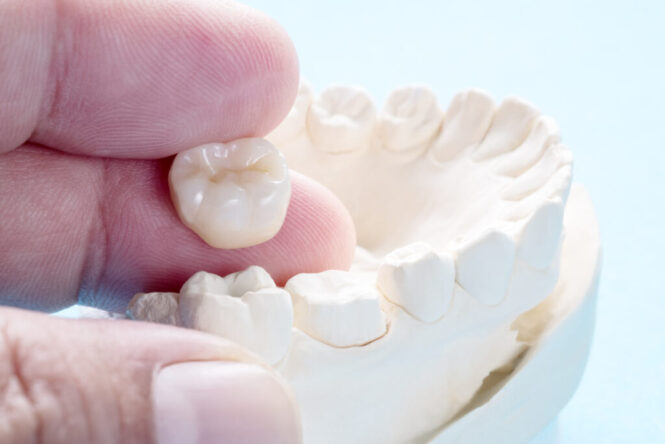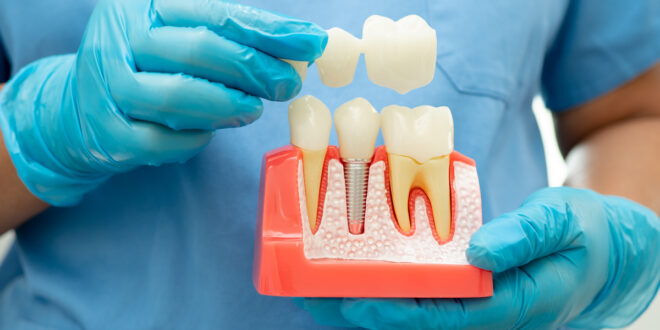When a tooth becomes too weak to hold a filling or resist everyday chewing pressure, the best solution is a dental crown. A properly fitted crown can restore nearly all of a tooth’s original strength, often up to 95% of its natural bite force, while protecting it from future fractures and decay. In simple terms, a crown gives a damaged tooth a second life, allowing it to function, feel, and look like it did before the damage occurred.
Crowns are not one-size-fits-all. They’re carefully designed from materials such as porcelain, zirconia, or metal alloys, each chosen for a specific reason.
For example, zirconia crowns offer extreme durability for molars that handle heavy chewing, while porcelain crowns are ideal for front teeth where appearance matters most.
|
Material Type |
Durability |
Appearance |
Typical Use |
| Porcelain | High | Natural tooth-like | Front teeth |
| Zirconia | Very high | Slightly opaque | Molars |
| Porcelain-fused-to-metal | High | Good aesthetic balance | Mixed use |
| Gold alloy | Extremely high | Metallic | Back teeth or grinders |
Each type is bonded securely to the tooth, acting as both armor and aesthetic restoration.
How Crowns Rebuild Strength and Stability

When a tooth loses its outer enamel layer, it becomes structurally vulnerable. The remaining dentin can no longer absorb the forces of biting or grinding. A dental crown works by enclosing the tooth in a solid shell that redistributes pressure evenly across the surface. This prevents micro-cracks from spreading and protects the remaining natural tissue underneath.
In the case of a root canal, for example, the tooth’s inner pulp is removed, leaving the structure hollow and weak. Placing a crown over that tooth restores full chewing function and prevents fracture. Similarly, patients with worn-down teeth due to grinding or acid erosion benefit from crowns because they rebuild height, maintain bite alignment, and restore facial balance.
Without reinforcement, weakened teeth often continue to deteriorate. A crown interrupts that cycle by acting as a permanent structural replacement.
The Process of Getting a Crown
The restoration process involves several key stages, each one aimed at long-term strength and accuracy.
- Preparation: The dentist removes decay, reshapes the tooth, and ensures that the underlying structure can support a crown.
- Impression or scan: A 3D scan or mold is taken to design the crown precisely.
- Temporary protection: A temporary crown protects the tooth while the permanent one is fabricated.
- Final placement: The finished crown is bonded using dental cement and adjusted for a perfect fit.
Modern clinics often use CAD/CAM milling technology to create crowns in a single appointment. These same-day crowns have accuracy down to microns, minimizing human error and improving comfort.
Function Meets Design

A high-quality crown doesn’t just restore chewing power; it restores confidence. It allows patients to eat naturally without pain or worry about cracks or breakage. Once cemented, the crown becomes part of the tooth’s functional system, protecting it from pressure and temperature sensitivity.
In some practices, like only crowns, advanced digital imaging and precision milling ensure every crown matches the patient’s bite pattern, gum contour, and shade. This combination of engineering and artistry creates a restoration that feels invisible, strong enough for daily function yet natural enough to blend perfectly with surrounding teeth.
Why Crowns Outperform Fillings in Severe Cases
Dental fillings repair minor cavities, but they depend on surrounding enamel for support. When more than half of the tooth’s surface is compromised, a filling no longer stabilizes it effectively. A crown, on the other hand, replaces the entire external structure, giving the tooth a new, continuous surface that behaves like enamel.
This difference is especially important for molars, which experience up to 200 pounds of biting force during chewing. A crown protects against both fracture and thermal stress while preventing bacteria from reaching the interior. It’s essentially a reinforced barrier that mimics natural tooth behavior.
|
Treatment |
Coverage Area |
Average Lifespan |
Strength Recovery |
| Small filling | Partial | 5–10 years | 50–60% |
| Inlay/Onlay | Partial | 10–15 years | 70–80% |
| Crown | Full | 15–25 years | 90–95% |
That difference explains why dentists often recommend crowns for teeth that have undergone repeated repairs or large restorations.
Biomechanical and Aesthetic Benefits

Crowns not only strengthen, but they also preserve harmony across the dental arch. When a damaged tooth is left untreated, surrounding teeth can shift toward the gap or tilt under uneven pressure. A crown keeps the natural spacing and alignment intact. This stability protects the jaw joint and supports balanced chewing.
From an aesthetic perspective, crowns recreate the natural translucency and contours of enamel. Porcelain and zirconia materials are carefully color-matched, making them indistinguishable from surrounding teeth. This is particularly beneficial for patients whose front teeth have deep staining or irregular shapes that veneers alone cannot correct.
Longevity and Maintenance
With proper oral care, dental crowns last 15 to 25 years, and often longer. Their durability depends on both material and maintenance. Brushing twice a day, flossing around the gum line, and avoiding habits like teeth grinding or chewing ice all extend their lifespan. Dentists may recommend a night guard to protect against pressure damage for patients with bruxism.
Routine dental checkups are equally important, as small gaps between the crown and tooth can allow bacteria to enter if not sealed correctly. Professional cleaning ensures the edges stay free from plaque buildup.
A Practical Investment in Oral Health
Replacing or reinforcing a damaged tooth isn’t just a cosmetic choice; it’s a structural one. Without protection, weakened teeth eventually break down, requiring extraction and expensive replacements like implants. A dental crown, by contrast, preserves the natural root and function while preventing bone loss in the jaw.
In clinical studies, teeth restored with full crowns have a survival rate exceeding 90% after 10 years, compared to just 60–70% for large composite restorations. That longevity makes crowns one of the most cost-effective and reliable options in modern restorative dentistry.
Conclusion
Dental crowns are the modern answer to structural tooth loss. They combine the resilience of advanced materials with the precision of digital dentistry to recreate natural performance. From reinforcing a fractured molar to rebuilding a worn smile, a crown does more than cover a flaw; it restores the foundation that allows the mouth to function as a complete system again.
 Imagup General Magazine 2025
Imagup General Magazine 2025

